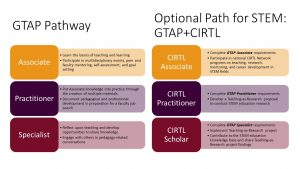Graduate students at Indiana University Bloomington have many opportunities to learn about, practice, improve upon, reflect on, and document their teaching activities. These teaching development activities are found in many places around campus – from programs in individual departments to centers like the Graduate Mentoring Center (GMC) and the Center for Innovative Teaching and Learning (CITL). These entities serve the range of experience levels and roles for graduate student instructors. Yet it can be difficult for graduate students to find and be connected with these resources, let alone to make sense of what’s most useful at any given time.
Two efforts on campus are collaborating to make pathways of teaching development more transparent, accessible, sustained, and verifiable. The Graduate Area Certificate in College Pedagogy, provides official acknowledgement on the university transcript of course-based participation in teaching development in four domains: Practicum, Theories and Concepts, Special Topics, and Research and Scholarship. This program helps graduate students interested in teaching make a coherent program of study around the almost 30 different discipline-based pedagogy courses on our campus.

Another teaching development pathway, the CITL’s Graduate Teaching Apprenticeship Program (GTAP), documents graduate students’ sequential participation in multi-disciplinary CITL activities. CITL events center on learning about cognition, memory, and motivation and practice with equity-based teaching strategies, service- and community-based learning, and instructional technology. Participants develop a community of scholars, document teaching activities, try out teaching technologies, and plan opportunities to share with others (see figure). A specialization track for graduate students in Science, Technology, Engineering, and Math is associated with IUB’s connection to the national CIRTL program, a nationally recognized educational and professional development program for graduate students and postdocs in STEM fields . Participants in the GTAP attend CITL/CIRTL workshops, consultations, and learning communities as fits their time and interests. We use a self-enrolling and self-paced GTAP Canvas course for participants to submit participation notices and documents such as a teaching philosophy statement, teaching portfolio, diversity statement, course proposal, and self-reflections and development plans. CITL staff confirm activity completion weekly and recognize level completion at the end of each semester.
Contact the leaders of the respective programs to get involved in either or both of these programs. Graduate students can pursue recognition in both programs simultaneously because the Certificate is course-based while the GTAP activity-based.
Thanks to Leslie Drane, Francesca White, and Rachel Boveja for their significant contributions to the GTAP program.

Leave a Reply